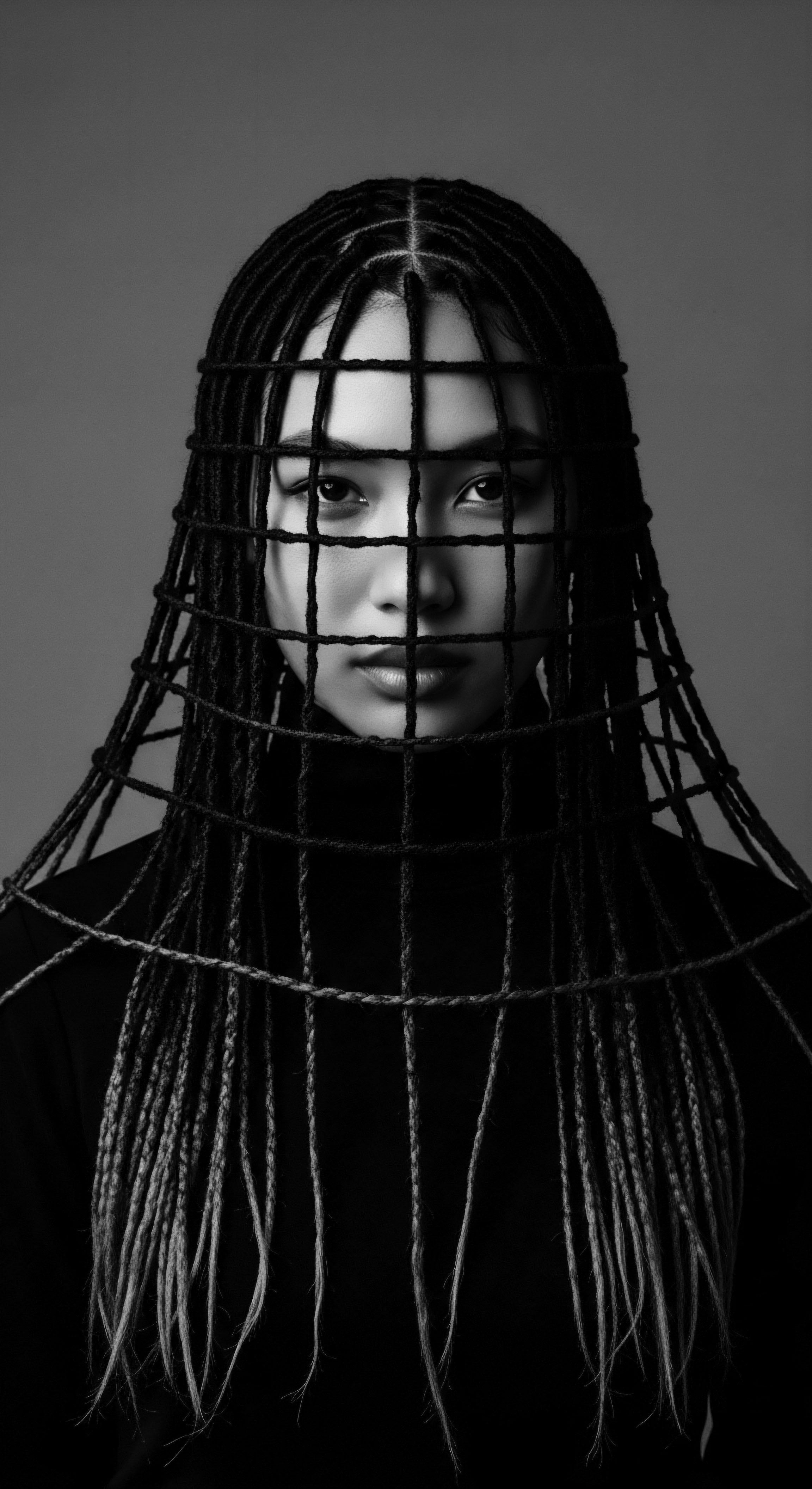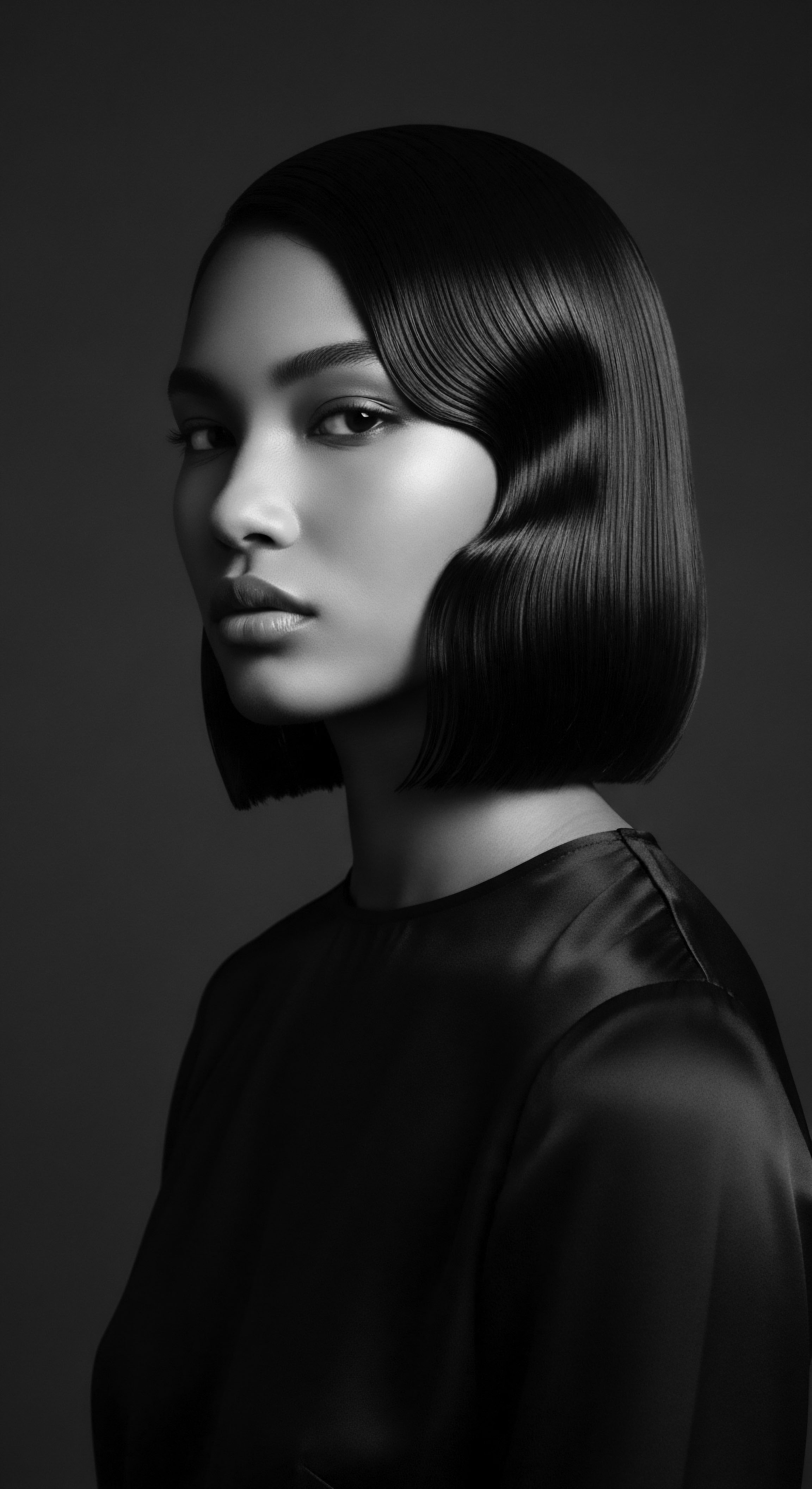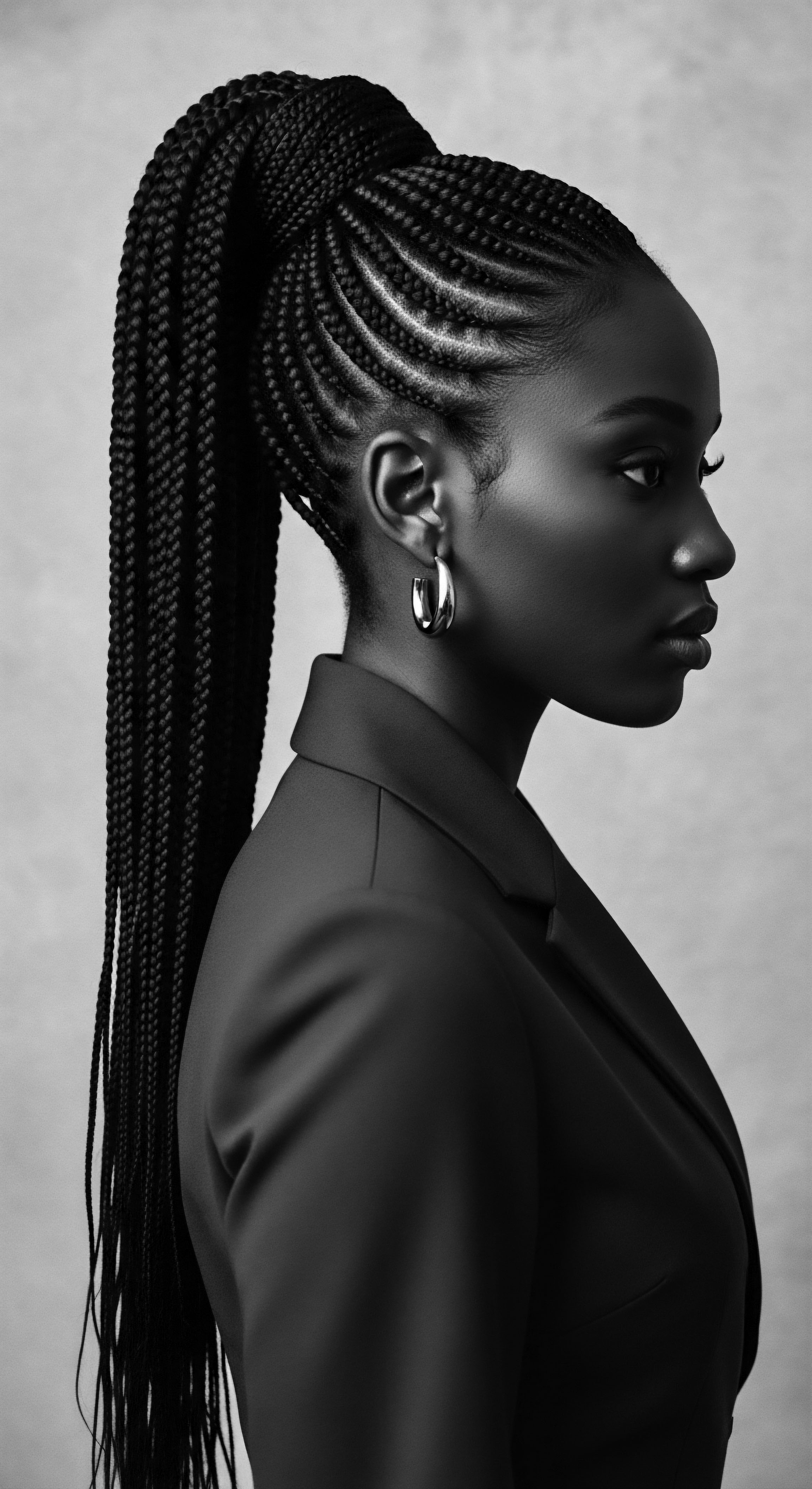
Roots
To journey into the heart of textured hair heritage is to stand at the precipice of time, where the very earth whispers secrets of care. For Black heritage, clay has never been a mere substance; it possesses a spirit, a deep connection to the land from which life springs. Consider the ancient hands, guided by wisdom passed through generations, reaching for ochre-rich earth.
This connection to the soil is not abstract; it lives within the narrative of textured strands, where clay practices forged a bond between humanity and the elemental world. Our exploration of clay’s significance is a walk through a living archive, where each hair strand holds stories of resilience, artistry, and a profound respect for nature’s offerings.

The Earth’s Embrace Ancient Beginnings
From the dawn of human adornment, various forms of clay and earth pigments played an undeniable role in personal expression across diverse African societies. These practices were seldom superficial. They spoke of identity, status, spiritual connection, and often, practical protection.
The earth, in its raw, mineral-rich form, provided not only nourishment for crops but also potent ingredients for maintaining the vitality and unique patterns of coiled and curled hair. The early use of these earthen materials laid a foundational understanding of hair care that spanned centuries, informing approaches to wellness long before modern chemistry emerged.
Clay practices represent an enduring link between Black heritage, textured hair, and the elemental wisdom of the earth.
The Himba people of Namibia offer a vivid illustration of this deep, historical bond. Their use of Otjize, a distinctive blend of butterfat and red ochre pigment, transcends mere cosmetic application. This rich, reddish paste, applied to both skin and hair, serves as a testament to ancestral ingenuity. Himba women, from the onset of puberty, meticulously coat their intricately plaited hair with otjize.
This application is not simply a beautifying ritual; it acts as a protective barrier against the harsh desert sun, shielding against UV rays, and aids in maintaining hygiene in an environment where water is scarce. Beyond its practical utility, otjize holds profound symbolic weight for the Himba, representing blood—the very essence of life—and the earth’s own vibrant, red color. Hairstyles, sculpted with this earthen compound, become intricate maps of identity, communicating a woman’s age, marital status, and social standing within the community.

What Does Hair Anatomy Reveal About Ancestral Care?
Understanding the very structure of textured hair sheds light on why clay practices held such enduring significance. The unique helix and curvature of Black hair strands, often presenting with an elliptical cross-section, mean that natural oils produced by the scalp travel down the hair shaft with less ease compared to straighter textures. This often results in a propensity for dryness, calling for external moisturizers and protective measures.
Ancestral communities, without the benefit of microscopes or chemical analysis, intuited these needs through observation and generations of experiential knowledge. Clay, with its varied mineral compositions, offered solutions that addressed these fundamental biological characteristics.
- Rhassoul Clay ❉ Sourced primarily from the Atlas Mountains of Morocco, this natural mineral clay possesses exceptional remineralizing and moisturizing properties. It was historically used as a cleansing agent that purified hair and scalp without stripping essential natural oils, a benefit critical for retaining moisture in textured strands.
- Kaolin Clay ❉ Often white or pale in color, Kaolin clay was utilized for its gentle cleansing and purifying qualities. Its mild nature made it suitable for sensitive scalps and for absorbing excess oil without causing dryness, a balanced approach to hair health.
- Bentonite Clay ❉ Known for its strong absorbent properties, Bentonite clay, particularly popular in various African communities, was employed to draw out impurities and detoxify the scalp. It also contributed to softening hair, making it more manageable for styling and detangling.
These earth-derived substances were integrated into regimens that honored the hair’s inherent nature, providing a foundation for practices that continue to shape textured hair care today. The ancestral understanding of hair was holistic, viewing the strand not in isolation but as part of an interconnected system of body, spirit, and environment. Early societies recognized that hair health was intrinsically linked to scalp well-being, a concept modern science now validates through studies on the scalp microbiome and its impact on hair growth.

Ritual
The application of clay to hair was rarely a solitary, utilitarian act. It unfolded as a ritual, a deliberate sequence of movements, ingredients, and intentions that bound individuals to their community and ancestral lineage. These customs were vibrant expressions of cultural continuity, transforming raw earth into a medium of adornment, protection, and social symbolism. The very act of preparing the clay, often mixing it with botanical extracts, oils, or animal fats, was itself a heritage ritual, passed from elder to youth, carrying with it tales and wisdom of generations past.

The Tender Thread of Preparation and Application
Traditional clay hair practices were deeply intertwined with daily life and significant life events. For many communities, gathering the clay from specific, revered sites was the first step, imbuing the material with sacredness before its practical use. Once collected, the clay would undergo a meticulous preparation process ❉ grinding it into a fine powder, sifting out impurities, and then combining it with other natural elements.
The choice of additives was not arbitrary; it reflected centuries of accumulated knowledge about local flora and fauna, and their synergistic effects with the earth’s minerals. For instance, the Himba’s blend of ochre with butterfat and aromatic resins speaks to a sophisticated understanding of both protective and aesthetic properties.
This blend, Otjize, served not just as a dye or a cleansing agent, but as a holistic application that nourished the hair and scalp, offered defense against environmental elements, and even functioned as an insect repellent. The application itself was often a communal endeavor, a moment for sharing stories, teaching techniques, and reinforcing social bonds. Hands moving through hair, shaping it with earthen pastes, were not merely styling; they were performing an act of intergenerational care, a silent dialogue across time. The result was often hair that felt softened, strengthened, and visibly vibrant, demonstrating an intrinsic knowledge of texture’s unique requirements.

How Did Clay Infuse Traditional Styling Heritage?
The influence of clay practices extended far beyond basic care, deeply shaping the aesthetic and symbolic landscapes of textured hair styling. In many traditional African societies, hair communicated status, marital condition, age, and even lineage or spiritual allegiance. Clay became a fundamental tool in sculpting these intricate messages. Its pliable nature, once mixed with liquids, allowed for the creation of precise forms, the reinforcement of braids, and the distinctive coating that defined certain styles.
| Traditional Application (Heritage) Otjize (Himba, Namibia) |
| Cultural Significance/Benefit Symbol of life, blood, and earth; protective barrier against sun and insects; indicates age and marital status. |
| Traditional Application (Heritage) Ibomvu (Southern African groups) |
| Cultural Significance/Benefit Pigmented red ochre clay used for beauty and holistic health, including hair masks for regeneration and vibrancy. |
| Traditional Application (Heritage) Rhassoul Clay (Morocco/North Africa) |
| Cultural Significance/Benefit Cleansing without stripping natural oils, enhancing moisture retention and manageability, particularly for dry textures. |
| Traditional Application (Heritage) Edo (Igbo, Nigeria) |
| Cultural Significance/Benefit Red clay used to dye hair, part of a broader body adornment practice signifying beauty and cultural pride. |
| Traditional Application (Heritage) These historical uses of clay speak to a profound wisdom regarding both hair care and cultural identity across African traditions. |
The color imparted by certain clays, particularly reds and yellows from ochre, held specific symbolic meanings. For the Himba, the rich red hue of otjize symbolizes not only blood and earth but also the very essence of life. This coloring was not simply about aesthetic appeal; it was a visual affirmation of connection to ancestral lands and the life force itself.
Hairstyles coated in these earthen pigments were living canvases, each curve and coil carrying ancestral memory and communal values. These practices demonstrate that hair styling was never detached from deeper cultural currents; it was a profound medium of expression, a language spoken through strands.
The communal aspect of clay application solidified intergenerational bonds and transmitted rich cultural knowledge.
The decline of these practices in some areas, sometimes due to colonial influences or the imposition of Western beauty standards, underscores the resilience of those communities who persevered in their traditions. The continued observance of such rituals today serves as a powerful reclamation of heritage, a conscious decision to honor ancestral ways in a contemporary world.

Relay
The enduring spirit of clay hair practices, inherited from generations past, continues to resonate within contemporary textured hair care, forming an unbreakable link in the ancestral relay. This connection moves beyond mere historical fact, manifesting as a living wisdom that informs modern holistic care and problem-solving approaches. The inherent properties of these natural earths—their capacity to purify, condition, and protect—are now being explored with a renewed scientific lens, validating the intuitive genius of our forebears. We find ourselves in an ongoing dialogue with ancient practices, understanding their profound implications for both hair health and cultural affirmation.

How Do Ancient Practices Inform Modern Hair Wellness?
The principles underpinning traditional clay hair treatments provide a remarkable blueprint for today’s holistic wellness advocates. In an era saturated with synthetic products, there is a distinct return to elemental ingredients, a movement that deeply acknowledges the efficacy of natural earth materials. Modern scientific inquiry often confirms what ancestral practices discovered through centuries of trial and observation. For example, the ability of certain clays to absorb excess sebum and impurities while leaving beneficial oils intact is a scientific reality that validates the historical use of clays for gentle cleansing, especially beneficial for the delicate nature of textured hair.
The application of clay as a cleansing mask, a practice observed across many traditional African societies, aligns with contemporary wellness philosophies that advocate for minimal intervention and natural ingredient sourcing. This approach respects the scalp’s delicate microbiome and hair’s structural integrity, allowing for detoxification without harsh stripping. Consider the concept of the “mud wash” or “clay rinse” prevalent in many natural hair regimens today; these practices are direct descendants of ancient applications, demonstrating a continuity of care that spans millennia.

Ancestral Wisdom and Hair Health Solutions
The challenges faced by textured hair—such as dryness, breakage, and scalp irritation—were not new phenomena to ancestral communities. Their reliance on clay often stemmed from its tangible ability to address these concerns. For instance, the use of clay, sometimes combined with hydrating butters or oils, helped to seal moisture into the hair shaft and promote a healthier scalp environment, which is crucial for growth and retention of length in textured hair. The mineral content found in various clays, including silica, magnesium, and calcium, offers micronutrient benefits that support scalp health, which in turn nurtures stronger strands.
One specific example of clay’s therapeutic qualities for textured hair comes from the study of Ibomvu, a red ochre clay used by various Southern African communities. This traditional ingredient has been employed for centuries as a hair treatment mask, with anecdotal and historical accounts suggesting its role in promoting cell regeneration and addressing skin ailments. While scientific studies on hair benefits are ongoing, the historical application speaks to a deep, experiential understanding of its restorative capabilities. This ancestral knowledge is a beacon, guiding us towards solutions that are not only effective but also culturally resonant and environmentally mindful.
- Scalp Cleansing ❉ Clay’s adsorptive properties draw out impurities, product buildup, and excess oils from the scalp without stripping its natural moisture barrier, fostering an environment conducive to healthy growth.
- Moisture Retention ❉ When combined with humectants or emollients, certain clays can help to create a protective barrier on the hair, aiding in moisture retention and reducing dryness, a constant concern for many with textured hair.
- Mineral Nourishment ❉ The trace minerals present in natural clays provide a gentle infusion of nutrients to the scalp, supporting follicular health and strengthening the hair from its very source.
The journey of clay hair practices, from ancient ceremonial adornment to modern holistic care, is a powerful testament to the resilience and adaptability of Black heritage. It is a dialogue between the earth’s timeless offerings and the ever-evolving needs of textured hair, a relay of wisdom that continues to inform and inspire.

Reflection
As we gaze upon the lineage of textured hair, the silent, enduring presence of clay practices stands as a monumental marker of heritage. It speaks of a profound connection to the earth, a reciprocity between human hands and the generous soil that nourished both body and spirit. This is where the ‘Soul of a Strand’ truly comes alive—not merely in the physical attributes of hair, but in the ancestral wisdom coiled into every curl through the very dust of the ground.
The cultural significance of clay for Black heritage is a story of ingenuity, survival, and deep reverence. It is a living, breathing archive, etched into the collective memory of a people, its principles echoing through time.
These practices remind us that beauty rituals were never separate from well-being, community, or identity. They were integral acts of self-affirmation and cultural preservation, especially in the face of adversity. The resilience of textured hair, often demonized or misunderstood in broader society, finds its roots in these ancient applications of earth.
The clays, whether ochre for protection and symbolism, or rhassoul for gentle purification, represent an unbroken chain of knowledge, passed from matriarch to progeny. They stand as a testament to the fact that Black communities, throughout history, innovated sophisticated systems of care from the resources available, turning earth into elixir, pigment into protection, and ritual into resistance.
Today, as we reclaim and celebrate the fullness of textured hair, we do so with the ancestors walking beside us, their wisdom a guiding light. The enduring appeal of natural ingredients, the understanding of holistic care, the recognition of hair as a profound marker of identity—these are not new discoveries, but rather a reconnection to ancient truths. The story of clay and Black hair is a timeless narrative, continually written with each gentle touch, each inherited ritual, and each conscious choice to honor the rich, vibrant heritage coiled within every strand. It asks us to look beyond the superficial, to feel the weight of history in our hands, and to remember that the most profound beauty often comes from the deepest, most elemental sources.

References
- Kalu, K. 1999. The Dynamics of Cultural Heritage in a Postcolonial Africa ❉ The Igbo Experience. Africa World Press.
- Ukwu, O. 2000. Igbo Art and Culture. Enugu ❉ Fourth Dimension Publishing.
- Willis, A. 1989. The Aesthetics of Blackness. Princeton University Press.
- Cole, H. & Aniakor, C. 1984. Igbo Arts ❉ Community and Cosmos. University of California, Los Angeles, Museum of Cultural History.
- Greene, B. 2006. African Hair ❉ Art, Symbol, and Celebration. Thomson Gale.
- Lambert, R. 2001. The World of Ancient Egypt. Oxford University Press.
- McNair, S. 1997. African Hairstyles ❉ Styles of Yesterday, Today, Tomorrow. Black Hair Media.
- Narada, J. 1998. Clay ❉ The Healing Power. Keats Publishing.
- Chaudhri, A. & Jain, N. 2009. The History of Cosmetics. Pragati Publications.
- DeMello, M. 2007. Encyclopedia of Body Adornment. Greenwood Press.
- Gomes, C. & Silva, F. 2007. The Use of Clay Minerals in the Treatment of Disease. Natural Beauty Publications.
- Hirst, K. 2000. Archaeological Site Reference Manual. Altamira Press.
- Rifkin, R. F. 2012. The Thermal Properties of Ochre and Its Use as a Sunscreen. Thesis, University of the Witwatersrand.
